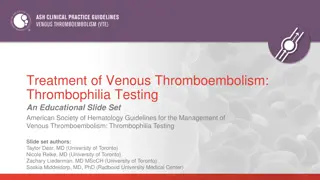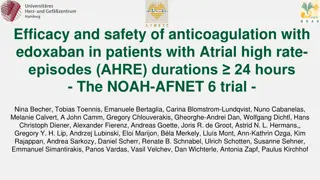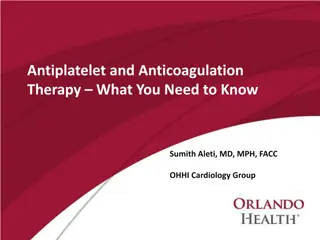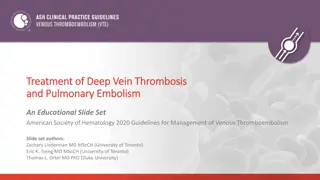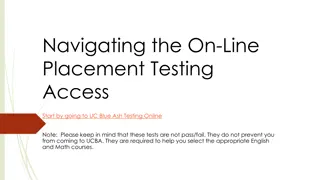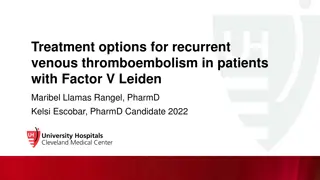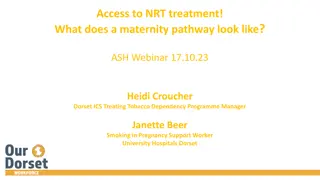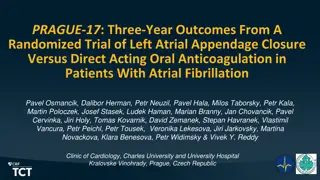Optimal Management of Anticoagulation Therapy - ASH 2018 Guidelines
The American Society of Hematology (ASH) 2018 guidelines focus on the optimal management of anticoagulation therapy, specifically in the context of venous thromboembolism (VTE). The guidelines cover topics such as prevention, treatment, and management strategies, developed through thorough panel formation, clinical questions generation, evidence synthesis, and recommendation processes. Recommendations are categorized as strong or conditional, emphasizing shared decision-making between patients and clinicians based on individual values and preferences.
Download Presentation

Please find below an Image/Link to download the presentation.
The content on the website is provided AS IS for your information and personal use only. It may not be sold, licensed, or shared on other websites without obtaining consent from the author. Download presentation by click this link. If you encounter any issues during the download, it is possible that the publisher has removed the file from their server.
E N D
Presentation Transcript
Optimal Management of Anticoagulation Therapy An Educational Slide Set American Society of Hematology 2018 Guidelines for Management of Venous Thromboembolism Slide set authors: Eric Tseng MD MScCH, University of Toronto Daniel Witt PharmD, University of Utah
Clinical Guidelines American Society of Hematology 2018 guidelines for management of venous thromboembolism: optimal management of anticoagulation therapy Daniel M. Witt, Robby Nieuwlaat, Nathan P. Clark, Jack Ansell, Anne Holbrook, Jane Skov, Nadine Shehab, Juliet Mock, Tarra Myers, Francesco Dentali, Mark A. Crowther, Arnav Agarwal, Meha Bhatt, Rasha Khatib, John J. Riva, Yuan Zhang, and Gordon Guyatt
ASH Clinical Practice Guidelines on VTE 1. Prevention of VTE in Surgical Hospitalized Patients 2. Prevention of VTE in Medical Hospitalized Patients 3. Treatment of Acute VTE (DVT and PE) 4. Optimal Management of Anticoagulation Therapy 5. Prevention and Treatment of VTE in Patients with Cancer 6. Heparin-Induced Thrombocytopenia (HIT) 7. Thrombophilia 8. Pediatric VTE 9. VTE in the Context of Pregnancy 10. Diagnosis of VTE
How were these ASH guidelines developed? PANEL FORMATION Each guideline panel was formed following these key criteria: Balance of expertise (including disciplines beyond hematology, and patients) Close attention to minimization and management of COI CLINICAL QUESTIONS 10 to 20 clinically- relevant questions generated in PICO format (population, intervention, comparison, outcome) EVIDENCE SYNTHESIS Evidence summary generated for each PICO question via systematic review of health effects plus: Resource use Feasibility Acceptability Equity Patient values and preferences MAKING RECOMMENDATIONS Recommendations made by guideline panel members based on evidence for all factors. Example: PICO question In patients with VKA- related life-threatening bleeding during treatment for VTE, should 4-factor PCC vs. FFP be used?
How patients and clinicians should use these recommendations STRONG Recommendation ( The panel recommends ) CONDITIONAL Recommendation ( The panel suggests ) Most individuals would want the intervention. A majority would want the intervention, but many would not. For patients Different choices will be appropriate for different patients, depending on their values and preferences. Use shared decision making. Most individuals should receive the intervention. For clinicians
Objectives By the end of this session, you should be able to 1. Describe recommendations for monitoring anticoagulant therapy 2. Describe recommendations for managing anticoagulant-associated bleeding 3. Identify drug-drug interactions relevant to the use of direct oral anticoagulants (DOACs)
What is this chapter about? Anticoagulants carry benefits (reducing thrombus extension, fatal PE) and risks (life- threatening bleeding) Recognizing and mitigating risk for harmfrom anticoagulants requires evidence-based approach to management This chapter focuses on the optimal management of anticoagulants for preventing and treating VTE (after choice of anticoagulant has already been made).
Case 1: New Deep Vein Thrombosis 52 year old female Past Medical History: Asthma, Diabetes, Obesity (weight 160 kg) Medications: Tiotropium, Salbutamol, Metformin Seen in the Emergency Department with: Swollen right calf x 4 days, no clear provoking risk factors. Elevated D-Dimer. Diagnosis: Proximal right leg deep vein thrombosis (superficial femoral and popliteal veins) on compression ultrasound
You decide to treat this patient with low molecular weight heparin (LMWH), bridging to a Vitamin K antagonist (VKA). Considering her high body mass (160 kg), how would you select her initial dose of LMWH? A. B. C. D. Dose should be capped at the highest available syringe size Dose should be based on actual body weight Dose should be based on calculated ideal body weight (based on age, gender, and height) Dose should be adjusted by peak anti-factor Xa levels
Recommendation In obese patients receiving LMWH for acute VTE, the panel suggests initial LMWH dose according to actual body weight rather than a fixed maximum daily dose (capped dose) (conditional recommendation, very low certainty) Dosing of LMWH based on actual body weight compared with capped doses: Low quality evidence, so benefit/harm unclear. Panel also considered: Desire to avoid underdosing large patients Poor correlation between anti-Xa levels and bleeding Anticipated absolute effects (95% CI) Outcomes (Quality of Evidence) Relative effect (95% CI) Risk with capped LMWH doses Risk difference using actual body weight Mortality Not estimable 0 out of 47 (0.0%) Not estimable 5 fewer PE per 1,000 (19 fewer to 95 more) RR 0.76 (0.11 to 5.45) PE 1 out of 47 (2.1%) 5 fewer DVT per 1,000 (19 fewer to 95 more) RR 0.76 (0.11 to 5.45) Symp. Prox DVT 1 out of 47 (2.1%) Major bleeding Not estimable 0 out of 47 (0.0%) Not estimable Quality of Evidence (GRADE): Low Moderate Strong
Recommendation In obese patients receiving LMWH for treatment of VTE, the panel suggests against using anti- factor Xa concentration monitoring to guide LMWH dose adjustment (conditional recommendation, very low certainty) Dosing LMWH based on monitoring anti-Xa concentration compared with no monitoring: Anticipated absolute effects (95% CI) Low quality evidence, so benefit/harm was unclear. Panel also considered: Concerns about anti-Xa test standardization and reproducibility Weak correlation between bleeding and anti-Xa levels Outcomes (Quality of Evidence) Relative effect (95% CI) Risk with no anti-Xa monitoring Risk difference with anti-Xa monitoring Mortality Not reported Not reported Not reported RR 3.06 (0.19 to 48.27) 11 more PE per 1,000 (4 fewer to 245 more) PE 1 out of 193 (0.5%) RR 1.53 (0.14 to 16.61) 5 more DVT per 1,000 (9 fewer to 162 more) Symp. Prox DVT 2 out of 193 (1.0%) RR 3.91 (0.67 to 22.95) 30 more bleed per 1,000 (3 fewer to 227 more) Major bleeding 2 out of 193 (1.0%) Quality of Evidence (GRADE): Low Moderate Strong
Case 1, Continued: You start LMWH based on actual body weight, and also start overlapping VKA. After 8 days, her INR is therapeutic and LMWH is stopped. You see her in follow-up in 3 months, and the decision is made to continue with VKA for secondary VTE prevention. 5 months later, she requires an elective colonoscopy as part of her routine age- appropriate cancer screening.
Your patient had an unprovoked DVT 8 months ago, and now requires a colonoscopy. What would you recommend for management of her VKA anticoagulation around the time of her elective procedure? A. B. C. Postpone procedure by 4 months to lower VTE risk Interrupt VKA before procedure, and give periprocedural bridging anticoagulation with LMWH Interrupt VKA before procedure, and give periprocedural bridging anticoagulation with unfractionated heparin Interrupt VKA before procedure, and do not provide any bridging anticoagulation D.
Recommendation In patients at low to moderate risk of recurrent VTE who require interruption of VKA for invasive procedures, the panel recommends against periprocedural bridging with LMWH or UFH in favour of VKA interruption alone (strong recommendation, moderate certainty) Periprocedural bridging compared with interruption of VKA therapy alone: Anticipated absolute effects (95% CI) Despite low quality evidence, strong recommendation against bridging because: Bridging LMWH consistently associated with increase in bleeding Possible reduction in risk of recurrent VTE is very small in this population Outcomes (Quality of Evidence) Relative effect (95% CI) Risk with VKA interruption alone Risk difference with periprocedural bridging 0 fewer deaths per 1,000 (0 fewer to 0 fewer) Mortality Not estimable 0 out of 1,236 (0.0%) PE Not reported Not reported Not reported RR 0.34 (0.02 to 6.58) 2 fewer DVT per 1,000 (2 fewer to 13 more) Symp. Prox DVT 3 out of 1,236 (0.2%) RR 31.73 (4.14 to 243.19) 25 more bleed per 1,000 (3 more to 196 more) Major bleeding 1 out of 1,236 (0.1%) Quality of Evidence (GRADE): Low Moderate Strong
VTE Recurrence Risk Stratification High Risk Moderate Risk Low Risk VTE within past 3 months Deficiency of protein C, protein S, or antithrombin Antiphospholipid antibody syndrome Multiple thrombophilic abnormalities VTE within past 3-12 months Heterozygous factor V Leiden Prothrombin 20210 mutation Recurrent VTE Active cancer VTE > 12 months previously No other risk factors
Aside: What if this patient was on a DOAC and required a scheduled invasive procedure? Recommendation In patients interrupting DOAC therapy for scheduled invasive procedures, the panel suggests against performing laboratory testing for DOAC anticoagulant effect prior to procedures (conditional recommendation, very low certainty) Remarks: Net health benefit/harm of DOAC laboratory testing before procedures is uncertain May consider testing when DOAC effect may be prolonged (renal failure, interacting drugs), time of last dose unclear, high procedural bleeding risk
Back to Case 1: You interrupt VKA 6 days prior to colonoscopy, without providing bridging anticoagulation. The colonoscopy proceeds uneventfully, and she is started back on VKA post-operatively. 3 years later she falls and strikes her head on the ground. She is taken to the Emergency Room. A computed tomography (CT) scan demonstrates a large subarachnoid hemorrhage with mass effect. Her Glasgow Coma Scale is 9, her neurologic status is deteriorating, and she requires urgent neurosurgery. INR is 2.4.
Your patient who is on VKA for management of VTE has a large traumatic intracerebral hemorrhage. INR is 2.4. What would you suggest for reversal of her VKA anticoagulant therapy? A. B. C. D. E. IV Vitamin K alone Prothrombin Complex Concentrate (PCC) alone Fresh Frozen Plasma (FFP) alone IV Vitamin K and PCC IV Vitamin K and FFP
Recommendation In patients with life-threatening bleeding during VKA treatment for VTE who have an elevated INR, the panel suggests using 4-factor PCC rather than FFP, in addition to cessation of VKA and intravenous vitamin K (conditional recommendation, very low certainty) PCC compared with FFP, in addition to intravenous vitamin K cessation of VKA: Given low certainty of effects, other driving factors for PCC recommendation: PCC: less volume overload, faster reduction of INR compared with FFP PCC easier to administer Outcomes (Quality of Evidence) Anticipated absolute effects (95% CI) Relative effect (95% CI) Risk with FFP Risk difference with PCC 10 fewer deaths per 1,000 (78 fewer to 159 more) RR 0.92 (0.37 to 2.28) Mortality 18 of 145 (12.4%) 15 more PE per 1,000 (0 fewer to 0 fewer) RR 7.71 (0.44 to 136.11) PE 0 of 23 (0.0%) 4 more DVT per 1,000 (2 fewer to 13 more) RR 2.57 (0.11 to 60.24) Symp. Prox DVT 0 of 23 (0.0%) 31 more bleed per 1,000 (20 fewer to 117 more) RR 1.34 (0.78 to 2.29) Major bleeding 12 of 132 (9.1%) Quality of Evidence (GRADE): Low Moderate Strong
Case 1: Summary Dosing of LMWH in obese individuals should be based on actual body weight. Peak anti- factor Xa concentrations are not helpful In individuals on VKA who are at low to moderate risk of VTE recurrence, bridging anticoagulation for invasive procedures increases bleeding without reducing VTE, and is not recommended Individuals taking VKA who have life-threatening bleeding should receive PCC (not FFP) in addition to intravenous vitamin K
Case 2: Managing DOAC-associated bleeding 70 year old male on rivaroxaban 20 mg daily for VTE prevention after recurrent unprovoked pulmonary emboli. Past History: Hypertension, Epilepsy (in remission, off anti-seizure medications x 5 years) Seen in the Emergency Department with: Frequent melena x 48 hours. Last dose of rivaroxaban was 4 hours ago. Hemoglobin has dropped from 12.0 g/dL (2 months ago) to 6.0 g/dL today. Blood pressure is 95/60, heart rate is 115 beats per minute Diagnosis: Upper GI bleeding exacerbated by rivaroxaban
Your patient is presenting with acute, life-threatening upper GI bleeding while on an oral direct Xa inhibitor. What management would you suggest for his DOAC-associated bleeding? A. Cessation of Xa inhibitor only B. 4-factor Prothrombin Complex Concentrate C. Coagulation factor Xa (recombinant) andexanet D. Fresh Frozen Plasma E. Idarucizumab
Two relevant recommendations: For patients with life-threatening bleeding during oral direct Xa inhibitor treatment for VTE: The panel suggests using either 4-factor PCC as an addition to cessation of the DOAC, or cessation of the DOAC alone(conditional recommendation, very low certainty) The panel suggests using coagulation factor Xa (recombinant) in addition to cessation of the DOAC, rather than no coagulation factor Xa (recombinant) (conditional recommendation, very low certainty) These recommendations do NOT apply to non-life- threatening bleeding.
Managing bleeding on Xa inhibitors Two main approaches 4-factor PCC Recombinant coagulation factor Xa (andexanet) However, the evidence for benefit and harm for either approach is very limited, so the panel does not offer a recommendation for one approach over the other Limitations of Current Studies 4-factor PCC and coagulation factor Xa have not been directly compared Studies of both approaches have lacked a suitable comparator group
These recommendations concerning reversal of direct Xa inhibitors do not apply to non-life-threatening bleeding In non-life-threatening bleeding, cost likely would outweigh potential benefit Small but quantifiable increased risk of thromboembolism associated with PCC administration Thromboembolic risks of recombinant coagulation factor Xa are uncertain Dentali F Thromb Haemost 2011 Connolly SJ NEJM 2016
What if your patient had been taking dabigatran instead, and presented with life-threatening upper GI bleeding? What management would you suggest for emergent dabigatran-associated major hemorrhage? A. B. C. D. E. Cessation of dabigatran only 4-factor Prothrombin Complex Concentrate Coagulation factor Xa (recombinant) andexanet Fresh Frozen Plasma Idarucizumab
Recommendation In patients with life-threatening bleeding during dabigatran treatment for VTE, the panel suggests using idarucizumab in addition to cessation of dabigatran rather than no idarucizumab (conditional recommendation, very low certainty) Remarks: Compared with non-idarucizumab control group, patients receiving idarucizumab may have had less worsening or recurrence of bleeding (RR 0.12 [95% CI, 0.03 to 0.43]) In one cohort study, 6.3% of patients who received idarucizumab for uncontrolled bleeding developed arterial or venous thrombosis within 90 days CV Pollack NEJM 2017
Is there a role for measuring DOAC anticoagulant effect when managing DOAC-related bleeding? Benefits and risks of measuring DOAC levels in bleeding patients are uncertain Drug Suggested Test Interpretation Do not delay treatment of DOAC- associated bleeding while waiting for DOAC test results Normal TT excludes clinically relevant levels Dabigatran Thrombin Time It is advisable not to rely on any single strategy in isolation to assess DOAC effect during bleeding management but instead to use a comprehensive approach. Normal anti-Xa activity likely excludes clinically relevant levels Rivaroxaban, Edoxaban, Apixaban Drug-specific Anti-Xa activity level Cuker & Siegal ASH Hematology 2015
Recommendation In patients receiving DOAC therapy for the treatment of VTE, the panel suggests against measuring DOAC anticoagulant effect during management of bleeding(conditional recommendation, very low certainty) Remarks: Low quality of evidence evaluating impact of measuring DOAC levels in bleeding patients Benefits and harms of measuring DOAC anticoagulant effects a uncertain Best not to delay intervention for bleeding while waiting for DOAC test result
Back to Case 2: Your patient receives 4-Factor PCC, and his rivaroxaban is temporarily suspended. He is started on an intravenous proton pump inhibitor. Gastroscopy reveals a 2 x 2 cm ulcer with a visible vessel that is clipped, and the patient s bleeding stops. He is discharged home on no antithrombotic therapy, to be reassessed at a later date.
This patient has been receiving anticoagulant therapy with a direct factor Xa inhibitor for recurrent VTE. He has had a recent upper GI bleed. How long after his bleeding event would you wait before resuming anticoagulant therapy? A. Within 1 week B. Between 2 weeks to 3 months C. Between 3 to 6 months D. Do not resume anticoagulant therapy
Recommendation In patients receiving anticoagulation therapy for VTE who survive an episode of major bleeding, the panel suggests resumption of oral anticoagulation therapy within 90 days rather than discontinuation (conditional recommendation, very low certainty) Resumption versus discontinuation of anticoagulant therapy for VTE after major bleeding: Increase in risk of recurrent bleeding offset by improvement in all-cause mortality Anticipated absolute effects (95% CI) Outcomes (Quality of Evidence) Relative effect (95% CI) Risk without resumption Risk difference with resumption 141 fewer death per 1,000 (79 fewer to 189 fewer) RR 0.59 (0.45 to 0.77) Mortality 845 of 2,455 (34.4%) Applies to patients requiring long-term or indefinite anticoagulation RR 0.26 (0.08 to 0.82) 21 fewer PE per 1,000 (from 5 fewer to 26 fewer) PE 12 of 425 (2.8%) RR 0.66 (0.25 to 1.75) 8 fewer DVT per 1,000 (18 fewer to 18 more) Symp. Prox DVT 11 of 464 (2.4%) RR 1.54 (1.18 to 2.02) 38 more bleeds per 1,000 (13 more to 71 more) Major bleeding 230 of 3,304 (7.0%) Quality of Evidence (GRADE): Low Moderate Strong
Back to Case 2: 3 weeks after the bleeding event, your patient has had no further bleeding and his hemoglobin concentration is stable. You start him back on rivaroxaban 20 mg daily. There is no further bleeding. 6 months later your patient has a seizure, which is felt by a neurologist to be due to his underlying epilepsy. The neurologist would like to start the antiseizure medication carbamazepine.
Which of the following antiseizure medications, when taken concomitantly with DOACs, may reduce DOAC plasma concentrations? A. Phenytoin B. Phenobarbital C. Carbamazepine D. All of the above
Recommendation For patients requiring administration of inhibitors or inducers of P-glycoprotein or strong inhibitors or inducers of CYP enzymes, the panel suggests using an alternative anticoagulant (such as VKA or LMWH) rather than a DOAC for the treatment of VTE (conditional recommendation, very low certainty) Remarks: DOAC absorption is mediated by P-glycoproteins (P-gp) CYP3A4 enzymes are involved in the metabolism of Xa inhibitors (not dabigatran) P-gp CYP3A4 Inhibitors DOAC effect DOAC effect Inducers DOAC effect DOAC effect
Drugs known to affect P-gp and/or CYP3A4 P-gp CYP3A4 Inhibitors Verapamil Dronedarone Itraconazole Ketoconazole Voriconazole Clarithromycin Atazanavir Darunavir Itraconazole Ketoconazole Nefazodone Clarithromycin DOAC effect Inducers Rifampin Carbamazepine Phenytoin Barbiturates St. John s wort Rifampin Carbamazepine Phenytoin Barbiturates St. John s wort DOAC effect
Carbamazepine is a CYP3A4 and P-gp inducer, which would result in decreased serum concentrations of rivaroxaban. You decide to transition your patient from rivaroxaban to VKA. What directions would you give your patient to transition from Rivaroxaban to VKA? A. B. C. D. Use LMWH bridging therapy Use intravenous heparin bridging therapy Use subcutaneous heparin bridging therapy Overlap DOAC and VKA until INR is therapeutic
Recommendation In patients transitioning from DOAC to VKA, the panel suggests overlapping DOAC and VKA therapy until the INR is within the therapeutic rangeover using LMWH or UFH bridging therapy (conditional recommendation, very low certainty) Remarks: Effect of using LMWH bridging therapy during transitions is very uncertain Use of LMWH is certain to increase burden and cost Be aware of varying potential of DOACs to influence (increase) INR test if overlap strategy used, INR should be measured just before next DOAC dose
Case 2: Summary Do not delay the treatment of DOAC-associated major hemorrhage while waiting for DOAC laboratory test results In individuals with VTE who require indefinite anticoagulation, consider resuming anticoagulation within 90 days of a major bleeding event Avoid DOACs in individuals who require concomitant treatment with strong inhibitors or inducers of P-glycoprotein or CYP3A4
Other guideline recommendations that were not covered in this session For these topics, conditional recommendations were made based on weak or very weak quality of evidence VKA management: point-of-care INR testing, INR recall interval Anti-factor Xa monitoring for LMWH in renal dysfunction Strategies for medication adherence and patient education Monitoring of renal function while on DOAC therapy
Future Priorities for Research Outcomes when DOACs used with P-gp/CYP3A4 inhibitors or inducers Outcomes when DOAC tests used for bleeding management Role for measuring DOAC anticoagulant effect before procedures Identifying when PCC should be used for reversal of Xa inhibitors Effectiveness of PCC versus coagulation factor Xa (recombinant) for reversal of bleeding on direct Xa inhibitors Timing of anticoagulant resumption after major bleeding
In Summary: Back to our Objectives 1. Describe recommendations for monitoring anticoagulant therapy Monitoring of DOAC anticoagulant effect is not necessary 2. Describe recommendations for managing anticoagulant-associated bleeding PCC and intravenous Vitamin K for VKA reversal Consider PCC or coagulation factor Xa for reversal of Xa inhibitors Idarucizumab for dabigatran reversal 3. Identify drug-drug interactions relevant to the use of direct oral anticoagulants (DOACs) Certain antiseizure, antifungal, antibiotic, HIV medications
Acknowledgements ASH Guideline Panel team members Knowledge Synthesis team members McMaster University GRADE Centre Author of ASH VTE Slide Sets: Eric Tseng MD MScCH, University of Toronto and Daniel Witt PharmD, University of Utah See more about the ASH VTE guidelines at http://www.hematology.org/VTEguidelines






